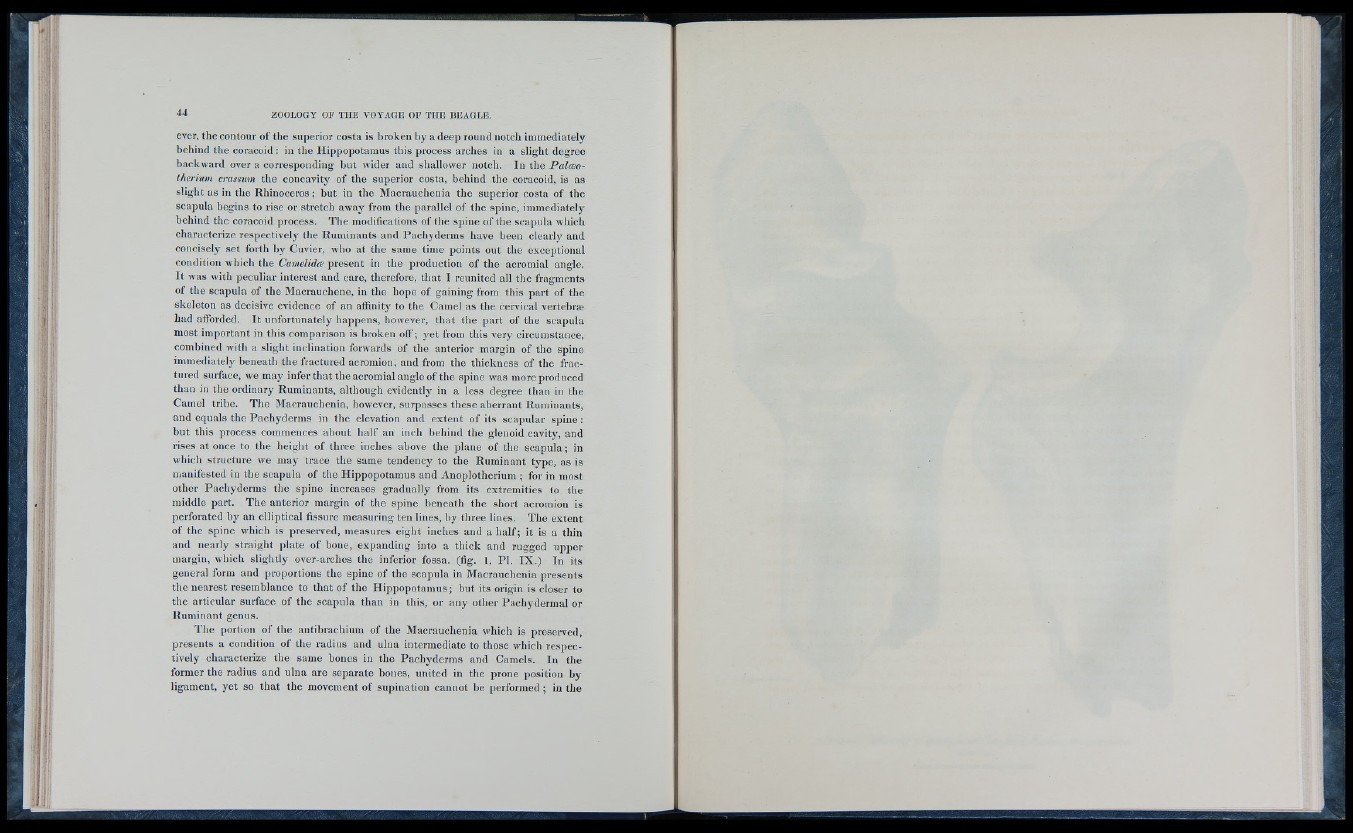
ever, the contour o f the superior costa is broken by a deep round notch immediately
behind the coracoid : in the Hippopotamus this process arches in a slight degree
backward over a corresponding but wider and shallower notch. In the Palæo-
therium crassum the concavity o f the superior costa, behind the coracoid, is as
slight as in the Rhinoceros; but in the Macrauchenia the superior costa o f the
scapula begins to rise or stretch away from the parallel o f the spine, immediately
behind the coracoid process. The modifications o f the spine o f the scapula which
characterize respectively the Ruminants and Pachyderms have been clearly and
concisely set forth by Cuvier, who at the same time points out the exceptional
condition which the Camelidæ present in the production o f the acromial angle.
It was with peculiar interest and care, therefore, that I reunited all the fragments
o f the scapula o f the Macrauchene, in the hope o f gaining from this part o f the
skeleton as decisive evidence o f an affinity to the Camel as the cervical vertebræ
had afforded. I t unfortunately happens, however, that the part o f the scapula
most important in this comparison is broken off ; y e t from this very circumstance,
combined with a slight inclination forwards o f the anterior margin o f the spine
immediately beneath the fractured acromion, and from the thickness of the fractured
surface, we may infer that the acromial angle o f the spine was more produced
than in the ordinary Ruminants, although evidently in a le ss degree than in the
Camel tribe. The Macrauchenia, however, surpasses these aberrant Ruminants,
and equals the Pachyderms in the elevation and ex ten t o f its scapular spine :
but this process commences about h a lf an inch behind the glenoid cavity, and
rises at once to the height o f three inches above the plane o f the scapula; in
which structure we may trace the same tendency to the Ruminant type, as is
manifested in the scapula o f the Hippopotamus and Anoplotherium ; for in most
other Pachyderms the spine increases gradually from its extremities to the
middle part. The anterior margin o f the spine beneath the short acromion is
perforated by an elliptical fissure measuring ten lines, by three lines. The extent
o f the spine which is preserved, measures eight inches and a ha lf; it is a thin
and nearly straight plate o f bone, expanding into a thick and rugged upper
margin, which sligh tly over-arches the inferior fossa, (fig. I, PI. IX .) In its
general form and proportions the spine of the scapula in Macrauchenia presents
the nearest resemblance to that o f the Hippopotamus; but its origin is closer to
the articular surface o f the scapula than in this, or any other Pachydermal or
Ruminant genus.
T h e portion o f the antibrachium o f the Macrauchenia which is preserved,
presents a condition o f the radius and ulna intermediate to those which respective
ly characterize the same bones in the Pachyderms and Camels. In the
former the radius and ulna are separate bones, united in the prone position by
ligament, yet so that the movement o f supination cannot be performed ; in the